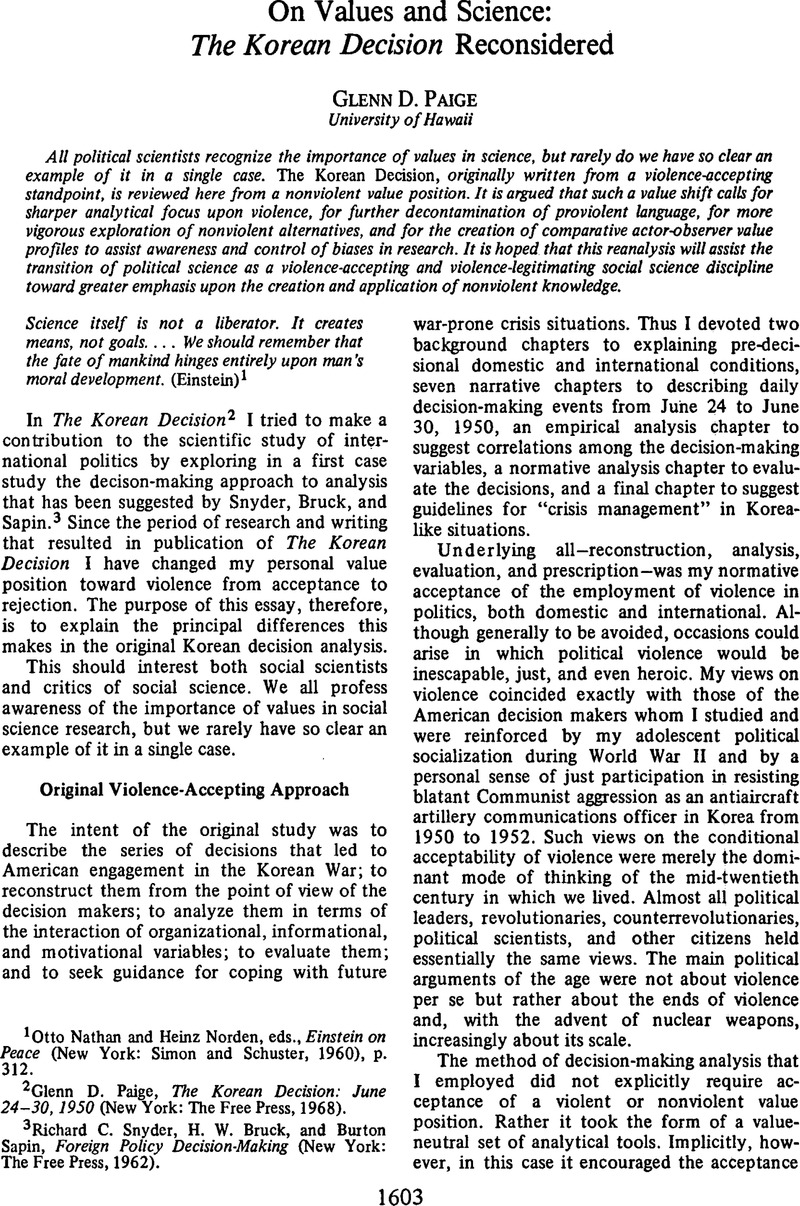Published online by Cambridge University Press: 01 August 2014

1 Nathan, Otto and Norden, Heinz, eds., Einstein on Peace (New York: Simon and Schuster, 1960), p. 312 Google Scholar.
2 Paige, Glenn D., The Korean Decision: June 24–30,1950 (New York: The Free Press, 1968)Google Scholar.
3 Snyder, Richard C., Bruck, H. W., and Sapin, Burton, Foreign Policy Decision-Making (New York: The Free Press, 1962)Google Scholar.
4 Paige, p. 352.
5 Ibid., p. 354.
6 Ibid., p. 24.
7 These figures are taken from the report of an expert commission created by the mayors of Hiroshima and Nagasaki in 1976. The losses are estimated as of December 1945, with a margin of error of ±10,000 persons in each case. The Hiroshima figure includes an estimated 20,000 military deaths. By 1950, total deaths attributable to direct bomb exposure are estimated as “more than 200,000” in Hiroshima and “more than 100,000” in Nagasaki. Takeshi Araki, mayor of the City of Hiroshima, and Yoshitake Morotani, mayor of the City of Nagasaki, Appeal to the Secretary General of the United Nations, n.p., October 1976, p. 31.
8 Paige, p. 54.
9 Only after experiencing value reversal did I begin to seek out and seriously study the excellent literature on nonviolent political alternatives; e.g., Gregg, Richard B., The Power of Nonviolence (London: George Roufledge, 1938)Google Scholar; de Ligt, Barthélemy, Conquest of Violence: An Essay on War and Revolution (New York: Garland, 1972)Google Scholar, reprint of 1937 edition; Bondurant, Joan V., Conquest of Violence: The Gandhian Philosophy of Conflict (Princeton: Princeton University Press, 1958)Google Scholar; Lynd, Staughton, ed., Nonviolence in America (Indianapolis: Bobbs-Merrill, 1966)Google Scholar; Unnithan, T. K. and Singh, Yogendra, Traditions of Nonviolence (New Delhi: Arnold Heinemann India, 1973)Google Scholar; and Sharp, Gene, The Politics of Nonviolent Action (Boston: Porter Sargent, 1973)Google Scholar.
10 Paige, p. 157.
11 Ibid., p. 82.
12 Ibid., p. 270.
13 Ibid., pp. 281–318.
14 Ibid., pp. 318–21.
15 Ibid., p. 321; emphasis in original.
16 Insert after propositions (i.e., after line 22) in ibid., p. 321.
17 Ibid., pp. 321–23.
18 The “resist aggression” characterization, rather than “to intervene,” was strongly advocated by Secretary of State Dean G. Acheson and accepted by me in Snyder, Richard C. and Paige, Glenn D., “The United States Decision to Resist Aggression in Korea: The Application of an Analytical Scheme,” Administrative Science Quarterly, 3 (12 1958), 341–78CrossRefGoogle Scholar. One problem with the “resist aggression” formula is that it implies total evil of the aggressor and that only military measures offer hope of successful resistance.
19 Appleman, Roy E., South to the Naktong, North to the Yalu (06–11 1950) (Washington, D.C.: Office of the Chief of Military History, Department of the Army, 1970), pp. 10–11 Google Scholar.
20 International Institute for Strategic Studies, The Military Balance, 1975–1976 (London: The International Institute for Strategic Studies, 1975), p. 56 Google Scholar.
21 The remarkable experiment by Tsai, in which after 700 trials he got a cat and a rat to cooperate in obtaining food without a coercive security barrier between them, can serve as a stimulus to constructive thought along these lines. See Tsai, Loh Seng, “Peace and Cooperation Among Natural Enemies: Educating a Rat-killing Cat to Cooperate with a Hooded Rat,” Acta Psychologia Taiwanica, 3 (03 1963), 1–5 Google Scholar.
Comments
No Comments have been published for this article.